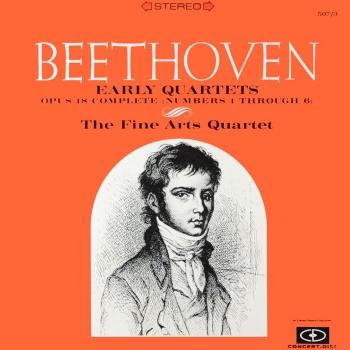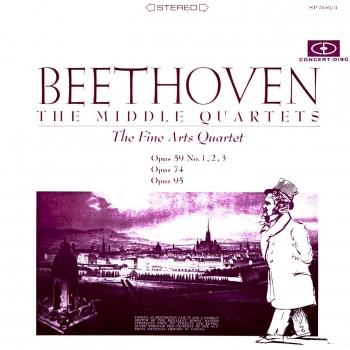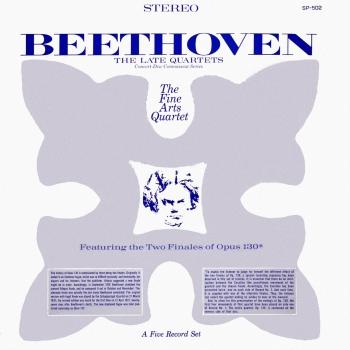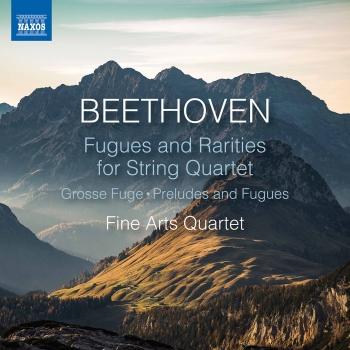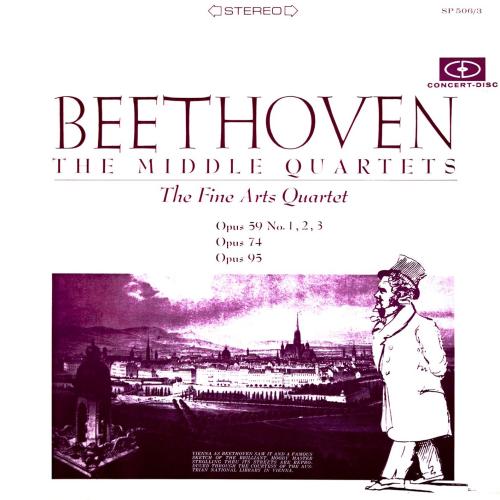
Beethoven: The Middle Quartets (Remastered from the Original Concert-Disc Master Tapes) Fine Arts Quartet
Album Info
Album Veröffentlichung:
2017
HRA-Veröffentlichung:
06.10.2017
Label: Concert-Disc, BMG Rights Management
Genre: Classical
Interpret: Fine Arts Quartet
Komponist: Ludwig van Beethoven (1770-1827)
Das Album enthält Albumcover Booklet (PDF)
Entschuldigen Sie bitte!
Sehr geehrter HIGHRESAUDIO Besucher,
leider kann das Album zurzeit aufgrund von Länder- und Lizenzbeschränkungen nicht gekauft werden oder uns liegt der offizielle Veröffentlichungstermin für Ihr Land noch nicht vor. Wir aktualisieren unsere Veröffentlichungstermine ein- bis zweimal die Woche. Bitte schauen Sie ab und zu mal wieder rein.
Wir empfehlen Ihnen das Album auf Ihre Merkliste zu setzen.
Wir bedanken uns für Ihr Verständnis und Ihre Geduld.
Ihr, HIGHRESAUDIO
- Ludwig van Beethoven (1770-1827): String Quartet No. 7 in F Major, Op. 59, No. 1 "Rasumovsky 1":
- 1 String Quartet No. 7 in F Major, Op. 59, No. 1 "Rasumovsky 1": I. Allegro 10:54
- 2 String Quartet No. 7 in F Major, Op. 59, No. 1 "Rasumovsky 1": II. Allegro vivace e sempre scherzando 09:04
- 3 String Quartet No. 7 in F Major, Op. 59, No. 1 "Rasumovsky 1": III. Adagio molto e mesto 11:09
- 4 String Quartet No. 7 in F Major, Op. 59, No. 1 "Rasumovsky 1": IV. Allegro 06:22
- String Quartet No. 8 in E Minor, Op. 59, No. 2 "Rasumovsky 2":
- 5 String Quartet No. 8 in E Minor, Op. 59, No. 2 "Rasumovsky 2": I. Allegro 07:46
- 6 String Quartet No. 8 in E Minor, Op. 59, No. 2 "Rasumovsky 2": II. Molto allegro 12:00
- 7 String Quartet No. 8 in E Minor, Op. 59, No. 2 "Rasumovsky 2": III. Allegretto 07:25
- 8 String Quartet No. 8 in E Minor, Op. 59, No. 2 "Rasumovsky 2": IV. Presto 05:18
- String Quartet No. 9 in C Major, Op. 59, No. 3 "Rasumovsky 3":
- 9 String Quartet No. 9 in C Major, Op. 59, No. 3 "Rasumovsky 3": I. Andante - Allegro vivace 08:25
- 10 String Quartet No. 9 in C Major, Op. 59, No. 3 "Rasumovsky 3": II. Andante con moto quasi allegretto 08:38
- 11 String Quartet No. 9 in C Major, Op. 59, No. 3 "Rasumovsky 3": III. Menuetto 05:18
- 12 String Quartet No. 9 in C Major, Op. 59, No. 3 "Rasumovsky 3": IV. Allegro molto 05:53
- String Quartet No. 10 in E-flat Major, Op. 74 "Harp":
- 13 String Quartet No. 10 in E-flat Major, Op. 74 "Harp": I. Poco adagio - Allegro 08:03
- 14 String Quartet No. 10 in E-flat Major, Op. 74 "Harp": II. Adagio ma non troppo 09:51
- 15 String Quartet No. 10 in E-flat Major, Op. 74 "Harp": III. Presto 05:06
- 16 String Quartet No. 10 in E-flat Major, Op. 74 "Harp": IV. Allegretto con variazioni 06:55
- String Quartet No. 11 in F Minor, Op. 95:
- 17 String Quartet No. 11 in F Minor, Op. 95: I. Allegro con brio 04:29
- 18 String Quartet No. 11 in F Minor, Op. 95: II. Allegretto ma non troppo 06:38
- 19 String Quartet No. 11 in F Minor, Op. 95: III. Allegro assai vivace ma serioso - Più allegro 04:40
- 20 String Quartet No. 11 in F Minor, Op. 95: IV. Larghetto espressivo - Allegretto agitato - Allegro 04:46
Info zu Beethoven: The Middle Quartets (Remastered from the Original Concert-Disc Master Tapes)
The period during which the Middle Quartets were written covers the years from around 1806 to 1810: the three Quartets, Opus 59 date from 1806-7, Opus 74 from 1809, and Opus 95 from 1810. During these same years, Beethoven composed his Fifth and Sixth Symphonies, the Violin Concerto, the E flat Piano Concerto, and the music to Egmont.
Historians have divided Beethoven’s works into three periods, not without basis. It is interesting to quote the noted musicologist, Gerald Abraham, as he reflects upon this middle period, which saw the closing of Classicism and the opening of Romanticism: “With Romanticism – one sees signs of the new attitude in late Haydn and late Mozart, years before Beethoven’s maturity – the whole conception, not of the quartet, but of music itself was
changing. A sonata or symphony or quartet was no longer a more or less objective piece of craftsmanship, shot through only with so much emotion as must always be spilled inadvertently into his creations by a craftsman of genius; it was a sublimated slice of the composer’s emotional life. Craftsmanship was becoming more and more a means only, not an end – and we must acknowledge that in reducing it to a mere means the composer lost a good deal of the pure joy of it.”
The Fine Arts Quartet was founded in 1946, although the group's members had actually begun working together as early as 1939 while playing in the Chicago Symphony Orchestra. The Quartet's first performance took place in 1940 with Leonard Sorkin, first violinist, Ben Senescu, second violinist, Sheppard Lehnhoff, violist, and George Sopkin, cellist. Military service in World War II intervened, however, and it was not until 1946, now with the new second violinist Joseph Stepansky, that the Quartet began to rehearse and perform regularly. The complete membership history of the Fine Arts Quartet, from 1946 to the present.
Abram Loft, violin
Leonard Sorkin, violin
George Sopkin, cello
Gerald Stanick, viola
Digitally remastered
The Fine Arts Quartet
was founded in 1946, although the group's members had actually begun working together as early as 1939 while playing in the Chicago Symphony Orchestra. The Quartet's first performance took place in 1940 with Leonard Sorkin, first violinist, Ben Senescu, second violinist, Sheppard Lehnhoff, violist, and George Sopkin, cellist. Military service in World War II intervened, however, and it was not until 1946, now with the new second violinist Joseph Stepansky, that the Quartet began to rehearse and perform regularly. The complete membership history of the Fine Arts Quartet, from 1946 to the present.
The Quartet performed on the ABC Radio Network's Sunday morning broadcasts from 1946 until 1954, and by the mid-fifties, was already considered one of America's finest quartets. There was an appearance on the Ed Sullivan Show, frequent performances on the Today Show, and starting in 1958, the Quartet began to tour Europe annually. In 1961, the Quartet toured Australia, and in the late sixties, the U.S. Department of State sponsored the Quartet's tours to Japan, Korea, Taiwan, Thailand, Australia and New Zealand. By the late seventies, the Quartet had already performed in some 270 cities in 28 countries. The Quartet continued to broadcast for radio in America (especially for WFMT-Chicago), in Europe (e.g. the BBC), and for television (concerts and educational programs for National Public Television).
The Quartet was also extremely busy recording, releasing an astonishing quantity of works (over 100) during its first 30 years of existence, including cycles of chamber music by Haydn, Mozart, Beethoven, Schubert, Mendelssohn, and Brahms, on such labels as Decca, Vox, Vanguard, and Concert Disc. But the Quartet was also appreciated for promoting contemporary music through performances, commissions, and recordings and played a major role in making composers such as Bartók, Shostakovich, Bloch, Babbitt, Wuorinen, Shifrin, Crawford-Seeger, Johnston, Husa, better known and accessible to the public.
During its early history, the Quartet had an impressive list of firsts to its credit. The Quartet gave the American premiere performance of the Shostakovich Quartet No.3 and was the first to record that quartet for radio and 78 rpm discs (with Mitch Miller as producer). It released the first complete stereo recording of the Bartók quartets, the first American recordings of the complete Beethoven quartet cycle, and the first stereo tape recordings (Dvorak and Debussy quartets). It recorded the first quartet series on educational television and the first educational film for the Encyclopedia Brittanica. Finally, it was the first quartet to appear on the Today Show, and to accompany a ballet (American Ballet Theater in New York).
The Quartet's first teaching residency, 1952-1955, was at Northwestern University. In 1963, after many years of summer concerts at the University of Wisconsin in Milwaukee, the Quartet was invited to become Quartet-in-Residence, and has been resident there ever since.
The Fine Arts Quartet
was founded in 1946, although the group's members had actually begun working together as early as 1939 while playing in the Chicago Symphony Orchestra. The Quartet's first performance took place in 1940 with Leonard Sorkin, first violinist, Ben Senescu, second violinist, Sheppard Lehnhoff, violist, and George Sopkin, cellist. Military service in World War II intervened, however, and it was not until 1946, now with the new second violinist Joseph Stepansky, that the Quartet began to rehearse and perform regularly. The complete membership history of the Fine Arts Quartet, from 1946 to the present.
The Quartet performed on the ABC Radio Network's Sunday morning broadcasts from 1946 until 1954, and by the mid-fifties, was already considered one of America's finest quartets. There was an appearance on the Ed Sullivan Show, frequent performances on the Today Show, and starting in 1958, the Quartet began to tour Europe annually. In 1961, the Quartet toured Australia, and in the late sixties, the U.S. Department of State sponsored the Quartet's tours to Japan, Korea, Taiwan, Thailand, Australia and New Zealand. By the late seventies, the Quartet had already performed in some 270 cities in 28 countries. The Quartet continued to broadcast for radio in America (especially for WFMT-Chicago), in Europe (e.g. the BBC), and for television (concerts and educational programs for National Public Television).
The Quartet was also extremely busy recording, releasing an astonishing quantity of works (over 100) during its first 30 years of existence, including cycles of chamber music by Haydn, Mozart, Beethoven, Schubert, Mendelssohn, and Brahms, on such labels as Decca, Vox, Vanguard, and Concert Disc. But the Quartet was also appreciated for promoting contemporary music through performances, commissions, and recordings and played a major role in making composers such as Bartók, Shostakovich, Bloch, Babbitt, Wuorinen, Shifrin, Crawford-Seeger, Johnston, Husa, better known and accessible to the public.
During its early history, the Quartet had an impressive list of firsts to its credit. The Quartet gave the American premiere performance of the Shostakovich Quartet No.3 and was the first to record that quartet for radio and 78 rpm discs (with Mitch Miller as producer). It released the first complete stereo recording of the Bartók quartets, the first American recordings of the complete Beethoven quartet cycle, and the first stereo tape recordings (Dvorak and Debussy quartets). It recorded the first quartet series on educational television and the first educational film for the Encyclopedia Brittanica. Finally, it was the first quartet to appear on the Today Show, and to accompany a ballet (American Ballet Theater in New York).
The Quartet's first teaching residency, 1952-1955, was at Northwestern University. In 1963, after many years of summer concerts at the University of Wisconsin in Milwaukee, the Quartet was invited to become Quartet-in-Residence, and has been resident there ever since.
Booklet für Beethoven: The Middle Quartets (Remastered from the Original Concert-Disc Master Tapes)










